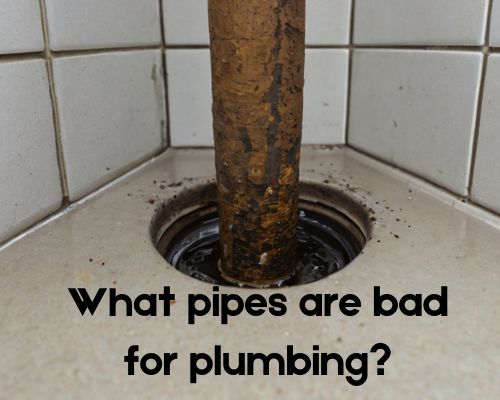When it comes to maintaining a functional plumbing system, choosing the right pipes is crucial. The wrong materials can lead to leaks, blockages, and costly repairs. In Australia, where plumbing regulations are strict and environmental conditions can be harsh, it’s essential to understand which pipes are bad for plumbing and why they should be avoided.

Common Problematic Pipes in Australian Plumbing
Over the years, various piping materials have been used in residential and commercial properties across Australia. However, some of these materials have proven to be unreliable and problematic. Here are the most notorious offenders:
1. Galvanized Steel Pipes
Galvanized steel pipes were commonly used in Australian homes built before the 1970s. While they were initially praised for their durability, they have significant drawbacks:
- Corrosion and Rusting – These pipes are coated with zinc, which deteriorates over time, leading to internal rust buildup and reduced water flow.
- Water Discoloration – Rusty pipes can cause brown or orange-tinted water, which is not only unsightly but can also stain fixtures and appliances.
- Short Lifespan – Compared to modern alternatives like PVC or copper, galvanized pipes have a much shorter life expectancy, making them a poor long-term investment.
2. Polybutylene Pipes (PB Pipes)
Polybutylene pipes were widely used from the 1970s to the 1990s due to their affordability and flexibility. However, they come with serious concerns:
- Prone to Brittle Cracks – Over time, polybutylene pipes degrade, leading to unexpected leaks.
- Chemical Sensitivity – Exposure to chlorine, which is commonly found in Australian water supplies, accelerates their deterioration.
- Insurance Issues – Many Australian insurance companies do not cover damages caused by polybutylene pipes due to their known failure rates.
3. Lead Pipes
While lead pipes are mostly found in older heritage homes, they pose serious health risks:
- Lead Contamination – Lead can leach into drinking water, causing severe health problems, particularly in children and pregnant women.
- Banned in Modern Plumbing – Australian plumbing codes have prohibited the use of lead pipes, but older properties may still contain them.
4. Copper Pipes with High Levels of Corrosion
Although copper is generally a good material for plumbing, improper installation and exposure to aggressive water can cause issues:
- Pinhole Leaks – Poor-quality copper pipes or water with high acidity can lead to pinhole leaks over time.
- Expensive Repairs – Replacing corroded copper pipes can be costly, especially if they run through walls or underground.
5. Orangeburg Pipes (Bitumen Fiber Pipes)
Rarely found in Australian homes but present in some old sewer lines, Orangeburg pipes are made of compressed wood fiber coated with tar. They have several downsides:
- Deterioration Over Time – These pipes collapse under pressure, leading to costly sewer blockages.
- Tree Root Infiltration – Since they weaken over time, tree roots can easily penetrate and cause blockages.
Signs That Your Pipes Need Replacing
If your home still has any of the pipes mentioned above, you may experience the following issues:
- Low Water Pressure – This is a common sign of corroded or clogged pipes.
- Discolored Water – Rust or lead contamination can cause brown or reddish water.
- Frequent Leaks – Small leaks can be a sign of a bigger plumbing problem.
- Unusual Taste or Odor – Water from deteriorating pipes may have a metallic or unpleasant taste.
- Increased Water Bills – Hidden leaks often lead to higher utility costs.
For more, go to Dean Owens of Plumber Warragul.
Best Pipe Materials for Plumbing in Australia
If you’re considering replacing your old plumbing system, here are the best alternatives:
- PVC (Polyvinyl Chloride) Pipes – Lightweight, corrosion-resistant, and ideal for drainage systems.
- PEX (Cross-Linked Polyethylene) Pipes – Flexible, easy to install, and highly resistant to bursting.
- Copper Pipes – Durable, long-lasting, and resistant to bacteria growth.
- HDPE (High-Density Polyethylene) Pipes – Used in modern plumbing and known for their strength and flexibility.
Final Thoughts
Choosing the right pipes is essential for a reliable plumbing system in Australian homes. If your home still has galvanized steel, polybutylene, or lead pipes, consider replacing them with modern alternatives. Regular plumbing inspections can help identify potential issues before they turn into costly problems.
For homeowners in Australia, working with a licensed plumber like Dean Owens of Plumber Warragul is crucial to ensure compliance with national plumbing codes and regulations. By making informed decisions about your plumbing system, you can prevent long-term damage and ensure safe and efficient water flow in your home.